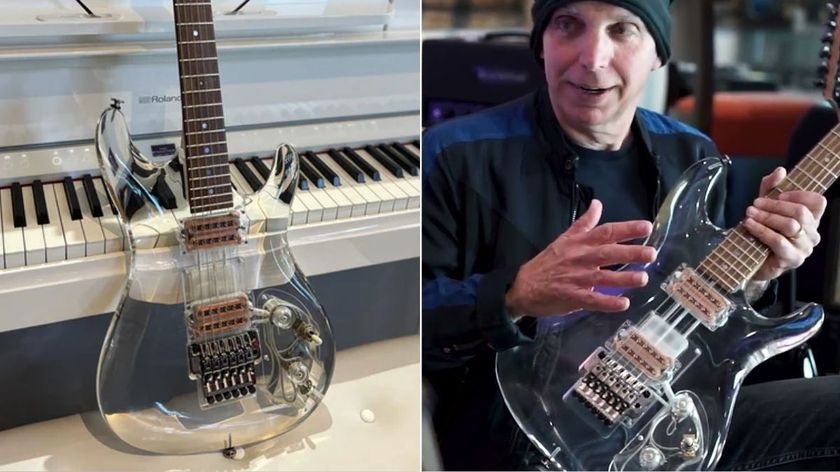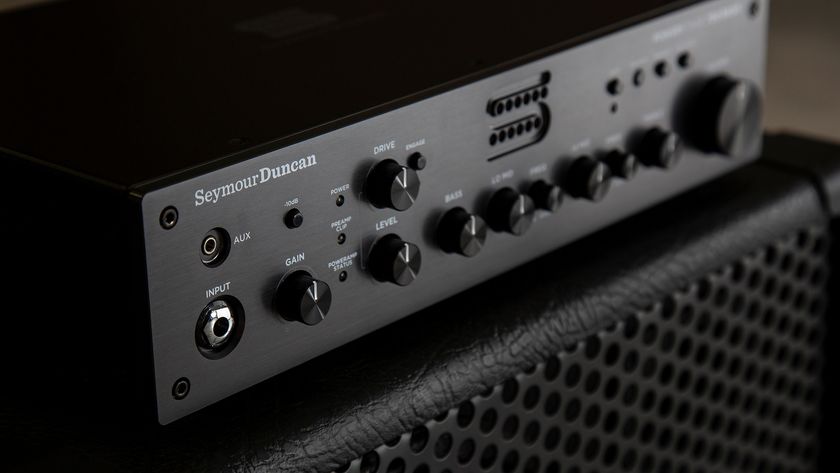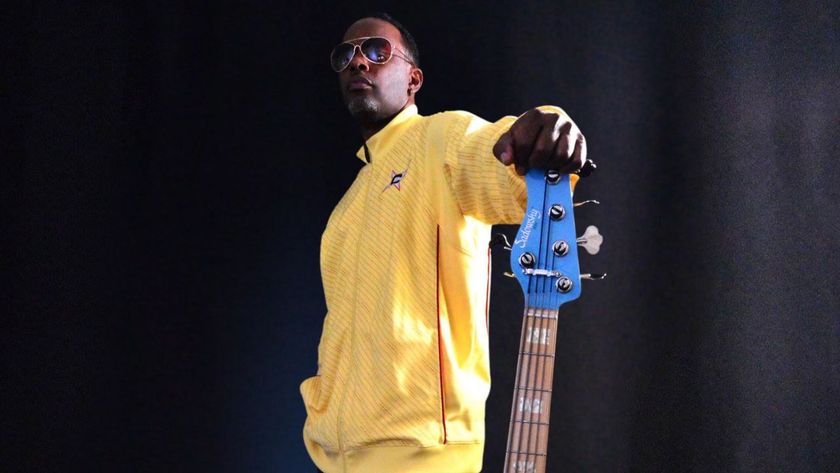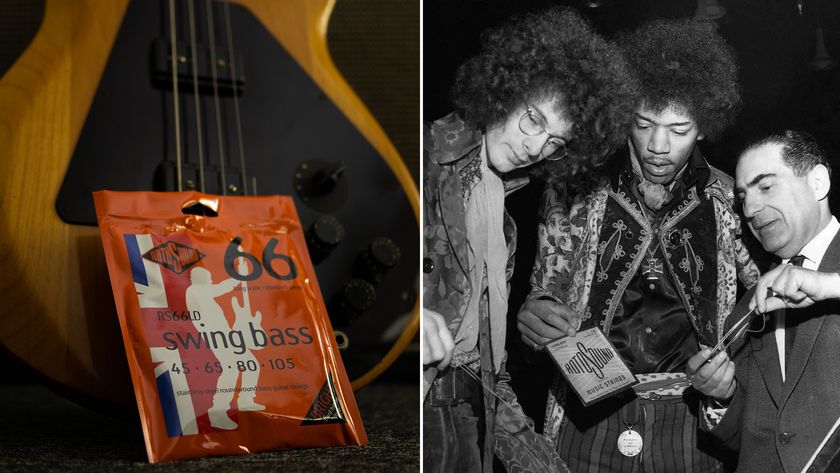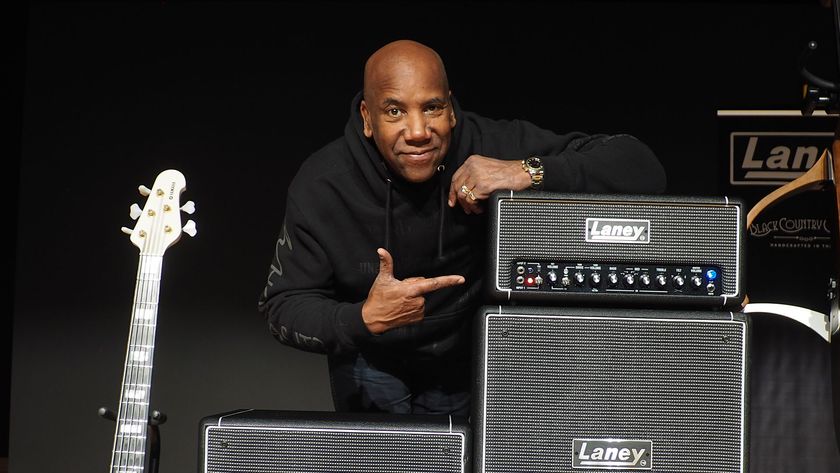Flamenco guitarist El Amir reveals how he ended up playing on the latest James Bond movie, No Time to Die
He's played with Stanley Clarke and Marcus Miller, and now the occasional Kramer-slinger discusses working and touring with legendary film composer Hans Zimmer
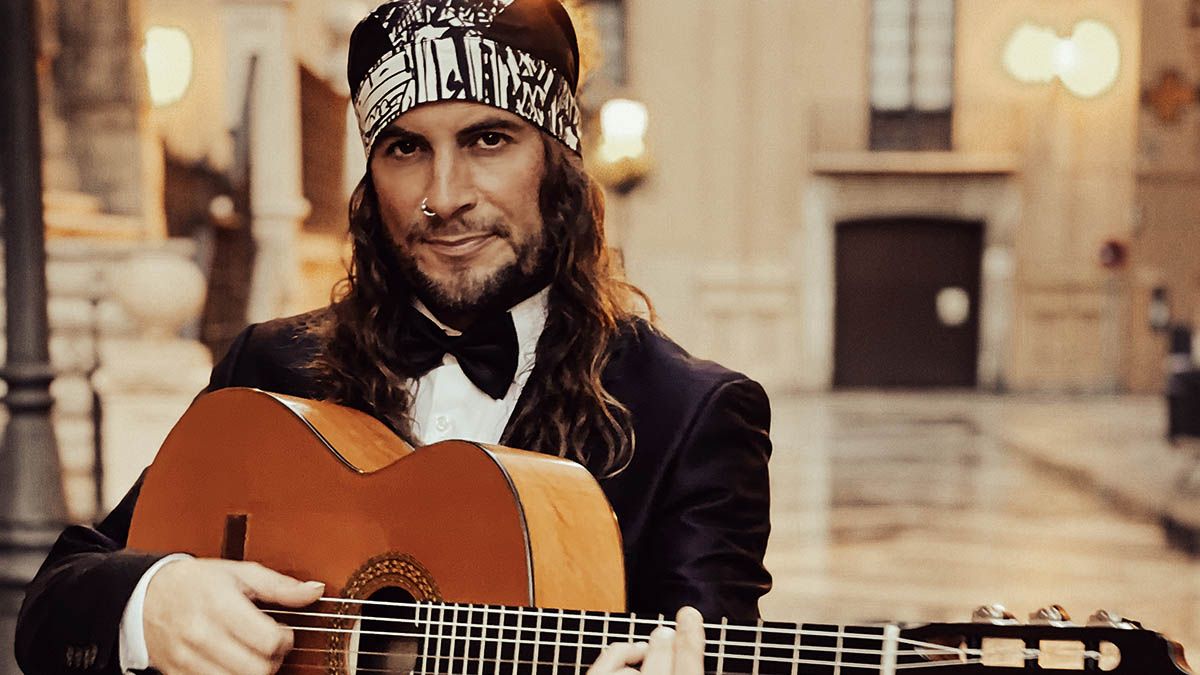
Also known as Amir John Haddad, El Amir is something of a double agent. Known internationally as one of the top flamenco stylists of his generation, he can also occasionally be found toting a Kramer guitar and rocking out on his own brand of “heavy rock funk metal”.
It’s a curious mix of styles, but El Amir himself insists that there is a connection between these two seemingly disparate musical entities and that is the dynamo of pure emotion that drives him.
Having played with artists including Stanley Clarke and Marcus Miller, El Amir also tours with film composer Hans Zimmer, playing film scores to stadiums and arenas worldwide in a live show. It was only a matter of time before his latest mission unfolded…
How did you come to play on the Bond soundtrack?
“In 2018, I was approached by the artistic direction team for Hans Zimmer through my management. They were looking for musicians to perform in The World of Hans Zimmer, which is Hans’ latest show, and since then I’ve been touring through arenas in Europe with him.
“Then he started to send me cues for some films and one day he said, ‘I have this beautiful project. You have to come to London, I want you to record for the Bond movie.’ And I was like, ‘Wow.’ When I got to London, I arrived just in time to be at a meeting that Hans was having with Cary Fukunaga, the director, and the whole team.
“After that, Hans had a little meeting with me about what he was looking for. Then I went to Stephen Lipson’s studio – he is a phenomenal producer – and I spent maybe three hours there and recorded a bunch of tracks and a bunch of guitar lines here and there. And that’s what they used. I think I’m on four songs of the soundtrack.”
Get The Pick Newsletter
All the latest guitar news, interviews, lessons, reviews, deals and more, direct to your inbox!
Were you playing flamenco guitar?
“Yes. In this case I played a Spanish nylon-string. I recorded very delicate stuff: arpeggios, nice melodies, some chords that fitted the emotion on screen. Hans is a genius, anyway, so he really uses an instrument for the sake of transmitting an emotion that is going on within his composition and within a scene.
“What I want people, or other musicians, to know is that when you record something for a movie it’s never about your skills or your ability to play your instrument. Everybody assumes that you need to be at a good level but everything else is just to focus on music, emotion, expression and dynamics.
“Sometimes even a very simple chord progression has to be played in a way that sounds very deep. It’s a beautiful concept because, as soloists, we’re used to performing on stage and showing what we have – the full programme of our technical range and everything. But for film music, it’s a little bit different.”
How did you first form an interest in flamenco guitar?
“I was born into a family with three cultures. My grandfather is from Hamburg and so he was German, but he eventually went to South America. So my mum comes from Colombia, she’s from Bogota, and my father is from the Middle East – he was born in Nazareth within a Palestinian family. Then, at a very early age, he came to Germany and studied physics.
“So I was surrounded by these three cultures. And, of course, with that, I was surrounded by the music. I would listen to German radio: classical, pop, rock, funk, whatever it was. And then the whole oriental and Arabic classical music from my father – he plays the Arabic oud – and he was such a lover of flamenco music because I think that was the music style that was the closest to his own culture, somehow. The singing, the tonalities and things like that.
I was lucky enough to listen to the basics of flamenco from a very early age and I started imitating my dad
“So even though I wasn’t born in Andalusia, I would listen to the old-style flamenco maestros such as Ramón Montoya, Sabicas, Paco de Lucía and all the generations that came after that. I was lucky enough to listen to the basics of flamenco from a very early age and I started imitating my dad.
“He would leave the instruments on the sofa. I would grab the oud or grab the guitar and fool around. One day my dad saw me grab the guitar and he said, ‘Do you want to learn more seriously?’ And I said, ‘Yes.’ So he took me to his teacher while he taught me the first steps at home.”
And when did your interest in rock guitar start to develop ?
“The elder brother of one of my friends – he was 16, we were 12 – handed us a cassette and on one side was Ride the Lightning and on the other Kill ’Em All by Metallica. That was probably the first conscious moment of listening to heavy metal or rock. For me, that was a new sound.
“The funny thing is, I didn’t know what an electric guitar was; I only knew my flamenco guitar and nylon strings. One day, shortly after that, I saw my first heavy metal magazine and I saw guys with long hair and those crazy-looking guitars and I said, ‘I need to have one of those.’
“So I would go downtown to some guitar stores, grab a guitar, plug in and try to play what I heard on those cassettes. And they would throw me out: ‘Okay, you’ve been playing for four hours, go home!’ Finally, my dad bought me an amp and an electric guitar, and that’s how it all started.”
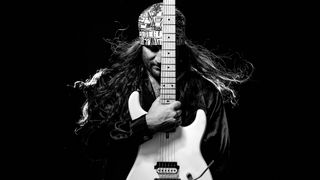
Flamenco and rock styles demand different playing disciplines – how does one style feed into the other for you?
“At first you might think that they are separate, but since I was able to learn the oud, which is played with a pick, and the guitar, which is fingerpicking, I learned both techniques without even realising it. As a little kid you just do it. So by the time I picked up the electric guitar, I felt very comfortable. I just had to adjust things a little with the pick to make it work.
“I think rock and flamenco have something in common, which is that energy that comes straight out of the guts, that emotional aspect of the music. I could kind of rely on that emotion and energy, and everything else was then just learning and refining technique, trying to learn repertoire.
“My way of learning was just play, stop, reverse on a cassette recorder. And I had to slow down vinyl – and then there were VHS cassettes that I recorded from TV shows. I would just try to pick up everything I could.”
Where is home musically for you?
“Since I’ve been exposed to so many languages, different emotional ways of feeling things, each culture gave me a different way of absorbing and understanding things. The same thing happens to me with music styles. I’ve opened up myself to so many music genres, and I’ve bought so many stringed instruments in order to be able to play those styles.
When I play flamenco guitar, I try to connect with a more meditative emotion. When I play oriental music, I try to evoke those feelings. And each culture has a different way of feeling the same…
“I like to play the saz when working on Turkish music, or Greek music with the bouzouki. I’ve really learned to appreciate them all. When I pick up one of my electric guitars, I just like to go and find really nice heavy, juicy-sounding riffs and then come up with nice motifs to solo on.
“When I play flamenco guitar, I try to connect with a more meditative emotion. When I play oriental music, I try to evoke those feelings. And each culture has a different way of feeling the same… You’re exposed to the same thing, but each culture will feel it differently. So I have the ability, maybe, to engage with that kind of emotional expression.”
You’ve recorded your own rock album. How did that happen?
“The rock thing was always a little bit of an aside because somehow my career evolved around the flamenco guitar and being a flamenco soloist. The rock thing was something that I always kept more private.
“Here or there I would play with bands, but my aim had to be on that other road because that was what was happening. Flamenco guitar is very exotic and it kind of gave me a place. And then one day I just said, ‘I have all those rock songs in my head, I need to lay them down.’
Being able to perform certain songs in a very raw kind of a band configuration is something I still need to explore
“So I went to a studio of a friend of mine in Madrid and laid down many songs, which I call ‘heavy funk rock metal’ because it’s the mix of all those four genres, basically. I played almost everything. On some songs I also played the bass. I didn’t play drums, though, because my level is not good enough, but I did all the vocals, all the overdubbing and they’re just out there.
“I never released the album – it’s on ReverbNation.com so you can easily access and listen to it. Eventually, I want to do something live because I think forming a power trio and being able to perform certain songs in a very raw kind of a band configuration is something I still need to explore.”
Let’s talk about gear. First of all, your flamenco guitar…
“When I was a little boy my father bought a guitar from Granada by a builder called José López Bellido, and I played that instrument for many years. Three years or four years ago I came up with an idea together with a friend of mine who builds guitars: ‘Why not do a signature flamenco guitar?’ It’s the Modelo ‘El Amir’, built by Jose Salinas.
“We ended up doing a year of research and finally we came up with a structure that I like and these are the guitars I’ve been using with Hans Zimmer. These are the ones that are on SpongeBob 3 [The SpongeBob Movie: Sponge on the Run] and The Boss Baby 2 and James Bond and so on. So it has been a beautiful journey for that instrument because it got to see the world a little bit. And, for me, it’s just an amazing feeling to have an instrument built by a friend – that connection is so rewarding.”
What’s your principal rock guitar rig?
“In 2019, I went to NAMM for the first time and I got this message on my WhatsApp from a Spanish friend who was working as a technician in London. He said, ‘If you’re at NAMM, talk to Danny Gomez from Orange. He’s a friend of mine.’ And so I thought, ‘Why not? Just go and say hi.’
“So I went there and we had such a good connection from the very first moment. He said, ‘We’re looking for a nylon-string player because we’re launching some acoustic amps and pedals – do you want to try them out?’ That’s how my relationship with Orange started.
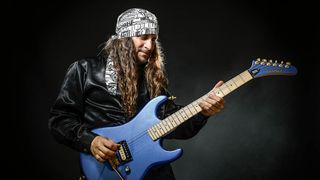
“After a year working on the acoustic side of things, they said, ‘Okay, let’s go and do the electric side,’ because they saw me performing with Hans Zimmer. So that’s now my electric gear – Orange amps, specifically a Pedal Baby 100 power amp, a Dual Terror head and a 4x12 cab.
“With guitars, I thought, ‘If I’m working with somebody at an endorsement level, it has to be about a relationship and it has to be something emotional. What is the most emotional guitar brand?’ Of course, Kramer. The sound I grew up to. I asked Danny Gomez and he said, ‘Talk to the artist relation manager at Gibson, Madrid.’ So
“I ended up getting two guitars from them – The 84 from the Kramer Icon Collection and a Baretta Special – and that’s how it all started. Sometimes it’s really not about how you plan things, it’s about things you really are longing for emotionally. It’s a whole different energy because I could have planned everything, and it wouldn’t have worked, right?”
- No Time to Die Official Motion Picture Soundtrack is out now via Decca.
With over 30 years’ experience writing for guitar magazines, including at one time occupying the role of editor for Guitarist and Guitar Techniques, David is also the best-selling author of a number of guitar books for Sanctuary Publishing, Music Sales, Mel Bay and Hal Leonard. As a player he has performed with blues sax legend Dick Heckstall-Smith, played rock ’n’ roll in Marty Wilde’s band, duetted with Martin Taylor and taken part in charity gigs backing Gary Moore, Bernie Marsden and Robbie McIntosh, among others. An avid composer of acoustic guitar instrumentals, he has released two acclaimed albums, Nocturnal and Arboretum.
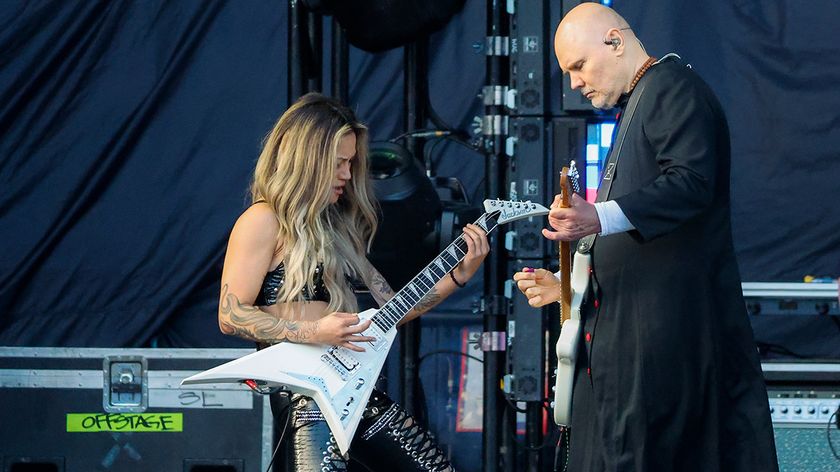
Billy Corgan announces new solo project featuring Smashing Pumpkins guitarist Kiki Wong, and U.S. tour celebrating classic Pumpkins eras
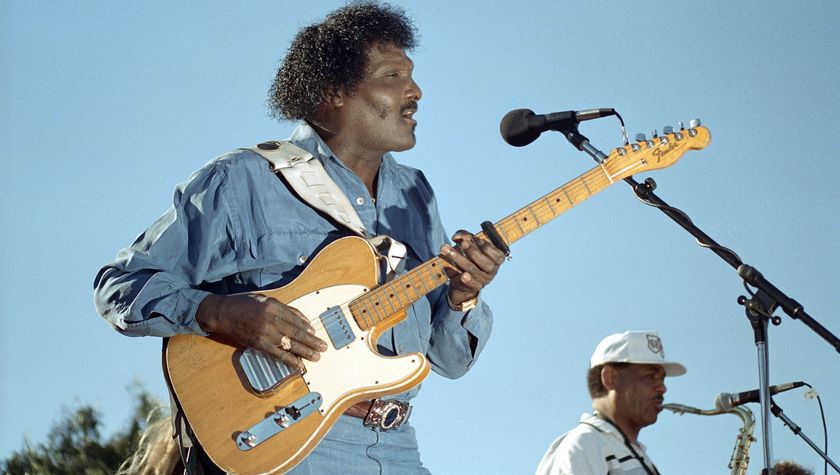
“Freddie King would ask me why I never tried using thumbpicks – I just couldn't play with one”: He took Jimi Hendrix's place in Little Richard's band, was idolized by Stevie Ray Vaughan, and is one of the most overlooked Telecaster slingers of all time

